New Brighton, New Zealand
New Brighton is a coastal suburb of Christchurch, New Zealand, 8 kilometres (5.0 mi) east of the city centre. The 2011 Christchurch earthquakes caused significant damage in the area.
New Brighton | |
|---|---|
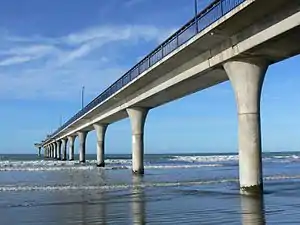 New Brighton Pier | |
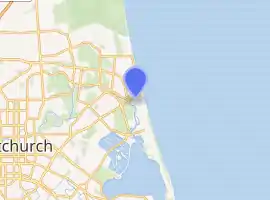 | |
| Coordinates: 43.508°S 172.726°E | |
| Country | New Zealand |
| City | Christchurch |
| Local authority | Christchurch City Council |
| Electoral ward | Coastal |
| Area | |
| • Land | 370 ha (910 acres) |
| Population (June 2021)[2] | |
| • Total | 6,180 |
| North New Brighton | ||
| (Residential red zone) |
|
(Pegasus Bay) |
| Bromley | (Avon Heathcote Estuary) | South New Brighton |
New Brighton is one of eastern Christchurch's main entertainment and tourist centres, with its architecturally unique pier and scenic coastline.
Naming
The naming of New Brighton was apparently done on a 'spur of moment' decision by William Fee, an early settler of the area. When Guise Brittan, the Waste Lands Commissioner, visited the area in December 1860, he was recognised and Fee chalked 'New Brighton' on a wooden plank, supposedly in reference to his fellow settler Stephen Brooker, who had come from New Brighton in England.[3] The Māori name for the area is Kaiuau (kai means food and aua is Yellow-eye mullet)[4] or O-ruapaeroa (an east wind blowing along the shore).[3]
The suburb is frequently referred to simply as Brighton, occasionally leading to confusion with Brighton near Dunedin.
New Brighton Pier
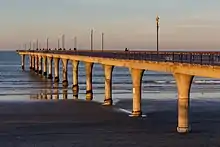
There have been two piers in New Brighton. The first pier, of wooden construction, opened on 18 January 1894 and was demolished on 12 October 1965. The current concrete pier was opened on 1 November 1997.[5] It is one of the icons of Christchurch. The pier was closed for earthquake repairs in 2016 reopened again in May 2018.[6]
Location
The suburb is divided into three sections spread along the southern coast of Pegasus Bay: North New Brighton; New Brighton; and South New Brighton, which lies at the northern end of a narrow peninsula between the bay and the Avon Heathcote Estuary. A 300 metres (980 ft) pier was built here in the 1990s, and opened on 1 November 1997.
New Brighton was originally a distinct coastal village, separated from the then outer suburbs of Christchurch by the swampy areas adjoining the Avon River. However, urban expansion, land reclamation and drainage have led to Brighton being connected to Christchurch city.
Demographics
New Brighton covers 3.70 km2 (1.43 sq mi).[1] It had an estimated population of 6,180 as of June 2021, with a population density of 1,670 people per km2.
| Year | Pop. | ±% p.a. |
|---|---|---|
| 2006 | 6,597 | — |
| 2013 | 5,946 | −1.47% |
| 2018 | 6,099 | +0.51% |
| Source: [7] | ||
New Brighton, comprising the statistical areas of New Brighton and Rawhiti, had a population of 6,099 at the 2018 New Zealand census, an increase of 153 people (2.6%) since the 2013 census, and a decrease of 498 people (-7.5%) since the 2006 census. There were 2,544 households. There were 3,018 males and 3,084 females, giving a sex ratio of 0.98 males per female, with 1,134 people (18.6%) aged under 15 years, 1,143 (18.7%) aged 15 to 29, 2,952 (48.4%) aged 30 to 64, and 876 (14.4%) aged 65 or older.
Ethnicities were 88.7% European/Pākehā, 14.2% Māori, 4.0% Pacific peoples, 3.4% Asian, and 2.5% other ethnicities (totals add to more than 100% since people could identify with multiple ethnicities).
The proportion of people born overseas was 18.5%, compared with 27.1% nationally.
Although some people objected to giving their religion, 59.7% had no religion, 27.1% were Christian, 0.4% were Hindu, 0.3% were Muslim, 0.5% were Buddhist and 3.9% had other religions.
Of those at least 15 years old, 846 (17.0%) people had a bachelor or higher degree, and 1,065 (21.5%) people had no formal qualifications. The employment status of those at least 15 was that 2,454 (49.4%) people were employed full-time, 708 (14.3%) were part-time, and 234 (4.7%) were unemployed.[7]
| Name | Population | Households | Median age | Median income |
|---|---|---|---|---|
| New Brighton | 3,330 | 1,431 | 39.5 years | $29,800[8] |
| Rawhiti | 2,769 | 1,113 | 37.5 years | $30,000[9] |
| New Zealand | 37.4 years | $31,800 |

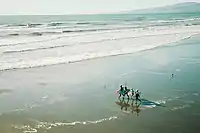

Saturday trading
For several decades, New Brighton had the distinction of being the only place in Christchurch where general retail shops were permitted to open on Saturdays[10] (remaining closed on Mondays), and the business district thrived as a result. With the introduction of nationwide Saturday trading in 1980, and then seven-day trading in 1990, retail activity declined significantly.[11][12]
Public transport
A variety of bus routes connect the city centre with New Brighton.[13]
Education
New Brighton Catholic School is a state-integrated full primary school for years 1 to 8.[14] It has a roll of 193 students. The school was established in 1935.[15]
Nova Montessori School is a private full primary school for years 1 to 8,[16] with a roll of 48 students. The school started in 1988, and moved to the current site in 2004.[17]
Both schools are coeducational. Rolls are as of March 2022.[18]
There are state primary schools in North New Brighton and South New Brighton.
Sport and recreation
A number of well known sports groups represent the local area. Some of the most notable groups are the New Brighton Rugby club. The New Brighton cricket club and the New Brighton Olympic Athletic club. Other groups include the Christchurch Archery club and New Brighton long boarders club. Also home of the oldest Surf Life Saving Club in New Zealand, The New Brighton Surf Bathing & Life Saving Club, established in 1910.
Christchurch earthquakes aftermath
Due in part to the ground on which it was built, the consequences for New Brighton of the 2011 earthquake did not only relate to building damage.
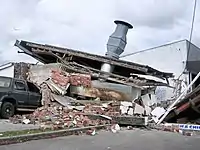

In December 2012 residents held a protest against the perceived slow progress of rebuilding in the area following the region's damaging earthquakes, in which 80 people bared their bottoms.[19] Christchurch Mayor Bob Parker said he wasn't offended, but the residents were "wrong". These feelings of neglect by the Christchurch City Council would continue to persist. Groups such as the Peoples independent Republic of New Brighton was formed by Paul Zaaman, The New Brighton Businesses and landowners association spokesperson, in order to protest lack of investment by the Christchurch City Council into New Brighton.
New Brighton was also named to be the host the finish of the annual Speight's Coast to Coast multisport race in February 2015. The previous finishing point of the race was in Sumner.
References
- "ArcGIS Web Application". statsnz.maps.arcgis.com. Retrieved 30 September 2021.
- "Population estimate tables - NZ.Stat". Statistics New Zealand. Retrieved 22 October 2021.
- Harper, Margaret (July 2011). "Christchurch Place Names" (PDF). Christchurch City Libraries. pp. 131f. Retrieved 1 October 2011.
- Reed, A. W. (2010). Peter Dowling (ed.). Place Names of New Zealand. Rosedale, North Shore: Raupo. p. 45. ISBN 978-0-14-320410-7.
- "New Brighton Pier". Christchurch City Libraries. Retrieved 23 April 2016.
- "New Brighton Pier reopens on Saturday following $8.5 million repair". Stuff. Retrieved 12 April 2020.
- "Statistical area 1 dataset for 2018 Census". Statistics New Zealand. March 2020. New Brighton (330200) and Rawhiti (328300).
- 2018 Census place summary: New Brighton
- 2018 Census place summary: Rawhiti
- "Christchurch – A Chronology – 1946". Christchurch City Libraries. Retrieved 14 October 2007.
- "East Christchurch". Te Ara: The Encyclopedia of New Zealand. Retrieved 14 October 2007.
- Walrond, Carl (13 July 2012). "Food shops – Shopping hours". Te Ara: The Encyclopedia of New Zealand. Retrieved 16 October 2014.
- "Metro". Metroinfo. Retrieved 22 June 2017.
- Education Counts: New Brighton Catholic School
- "Sisters of Our Lady of the Missions" (PDF). New Brighton Catholic School. Retrieved 30 September 2021.
- Education Counts: Nova Montessori School
- "About Nova Montessori School and Early Childhood Centre - History". Nova Montessori School. Retrieved 30 September 2021.
- "New Zealand Schools Directory". New Zealand Ministry of Education. Retrieved 23 April 2022.
- "Angry residents hold 'cheeky' protest". 3 News NZ. 2 December 2012. Archived from the original on 7 January 2014. Retrieved 18 January 2013.